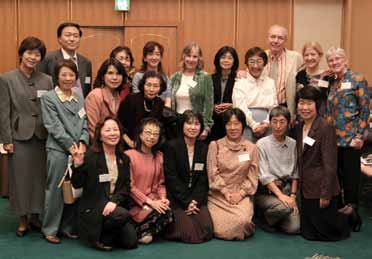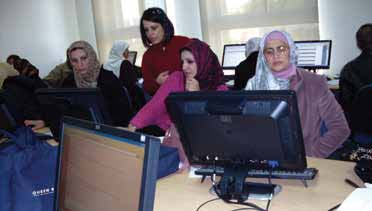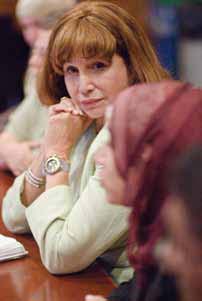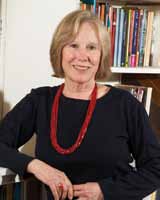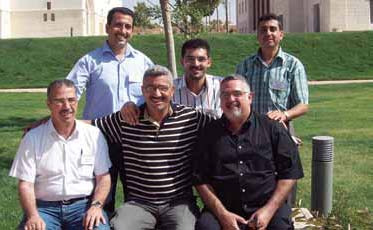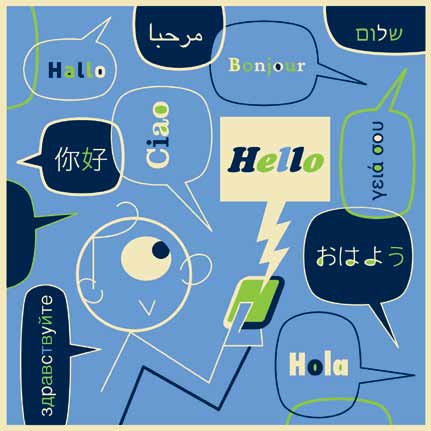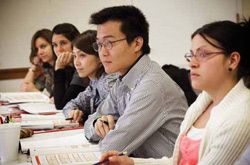Filed Under > Research/Publications
Language as Ambassador
TC's program in TESOL-'"the teaching of English to speakers of other languages-'"has long attracted foreign students. Now it's central in forming partnerships abroad.
They had two things in common. One was the hope for better employment: The Japanese woman was looking to improve her chances of getting another banking job when she returned to her country; the au pairs were hoping to use English "at university"; the Mexican woman was looking for better work back home. The other was their desire to learn English: The class they were registering for was the Community English Program, taught by students in TC's program in TESOL (Teaching English to Speakers of Other Languages). As Luis Yascaribay, the baker at Fairway, put it, “It’s very good for us to learn English. For a good future."
English has long been regarded as a leg up by students around the globe. Even before the emergence of the global economy, English as a Foreign Language had become a standard offering in school systems in most countries, and the demand for qualified teachers has been rising steadily for decades.
TC's TESOL program is the oldest in the country and is always ranked among the very best. In addition to the Community English Program, which each semester serves 375 adults locally, the College's TESOL program consists of master's and doctoral degree programs in New York City; an M.A.- in-TESOL extension program at TC's branch campus in Tokyo; and the summer certificate program in New York City, which has become the model for the College’s recent TESOL collaborations with other countries. Students in the degree-awarding programs may opt for either the TESOL K–12 Track, which trains them to teach English to K–12 students in the United States, also awards them a New York State TESOL K–12 teacher certificate, and includes a practicum in New York City public schools; or the TESOL General Track, which trains them to work with adults in the United States or abroad via field placements in the Community English Program. The core curriculum in the M.A. program in TESOL and Applied Linguistics focuses on courses related to the language itself (pedagogical English grammar, phonetics and phonology), language pedagogy, second language acquisition and second language assessment. The Ed.M. and doctoral programs offer specializations in language teacher education, language use (i.e., discourse analysis or sociolinguistics), second language acquisition and second language assessment.
The College has always drawn TESOL students who are scholarly and cosmopolitan. More recently, though, ministries of education and universities from other countries have been beating a path to the College’s door with requests for the TESOL program to export its expertise wholesale.
This past year, as TC has dramatically intensified its international focus, TESOL has gotten the green light to respond to those requests, launching a full-scale program in Jordan and laying the groundwork for a similar effort in Korea.
"The College has recognized that TESOL has an important role to play in international contexts,” says TESOL and Applied Linguistics Program Coordinator James Purpura, Associate Professor of Linguistics and Education. “This is also our way of being ambassadors for the country.”
It’s a role for which TC’s practitioners are particularly suited, since they make a point of striving to understand the contexts and nuances of the cultures to which they are exporting the language.
“Language and culture are inseparable," says TESOL faculty member ZhaoHong Han, Associate Professor of Language and Education. "So when we teach language, the kinds of content that we provide to our students intrinsically carry some cultural content. Even though we’re not teaching American culture, we are putting across some cultural information as well."
Case in point: Leslie Beebe, Professor of Linguistics and Education and one of the original members of the faculty of the TESOL M.A. program at TC Tokyo, has focused her research on intercultural communication, especially between Japanese and Americans. She has published numerous articles on cross-cultural differences in refusals, disagreements, corrections, chastisements and telling people embarrassing information (e.g., "you have spinach in your teeth"). Her papers on these topics show that even small differences in language choices can lead to serious cross-cultural misunderstandings. Beebe has also studied intercultural differences in rude language and in the way people from various linguistic backgrounds respond to rudeness. Most researchers and teachers of English as a Second/Foreign Language have focused on ways of being polite, but that leaves non-native speakers powerless to deal with rudeness when they encounter it.
Preventing such communication breakdowns is at the heart of what TESOL does.
"As the world gets smaller and people are thrown into professional situations where they have to buy and sell and negotiate with other people, it's sometimes the unspoken cultural assumptions that undermine communication more than a lack of appropriate grammar or a lack of vocabulary—or how much you have to protect the other person’s face and show respect," says Linda Wine, Director of TC's TESOL Certificate Program. "These are all critical, critical issues. And they’re often totally ignored or misunderstood. And that can cause real problems. What we want is for people to be communicatively competent, to not only know the rules of the language and have the vocabulary, but to be able to use the language in socially appropriate ways across a whole spectrum of experiences."
Breaking New Ground
Negotiating those differences has been an essential part of the TESOL program's collaboration with partners in Jordan. The partnership was born in fall 2006, when TC President Susan Fuhrman met Queen Rania of Jordan at a dinner at the New York City home of Columbia President Lee Bollinger. Subsequently, Columbia and the Queen agreed on a broad collaboration that, in March 2009, took the form of a new Columbia University Center of Excellence in Amman.
From the first, TC has been central to Columbia's work. When Bollinger, Fuhrman and faculty from both Columbia and TC visited Jordan in winter 2007, it became clear that one major need within Jordan's public schools was for English teachers there to improve their practice. That summer, 11 Jordanian teachers came to New York City to spend seven weeks attending the summer TESOL program. The Jordanians valued the technical learning but described the broader experience as nothing short of a revelation.
"I found things here very different from the ideas we get in the movies," Tahani Al-Momani, one of the visiting teachers, told Fuhrman at the end of her stay. "Americans are nicer, more hospitable, have more traditions and also have more—I am sorry for the word—manners."
And Affaf Koshman, another teacher, told Fuhrman, "I was afraid when I came here that people would dislike me—that they would see a woman wearing a headscarf and make assumptions about who I am. Instead, people have been so friendly. And I realize that I came with my own preconceptions as well. I did not think, for instance, that I would be able to make friends with Jewish people, but I was wrong—I have made some very warm friendships. So this has been a great thing."
Following that visit, TC faculty members again made site visits to schools in Jordan. In August 2008, after extensive consultation with the Jordanian education ministry, Jordanian universities and the teachers who had come to New York, TESOL faculty members from TC conducted an initial three-week TESOL program in Amman, timed to coincide with the Jordanian teachers’ summer vacation. A cohort of 35 K–12 teachers participated.
"They were full-time students, and it was very, very intense,” says Jim Purpura. “They could really concentrate for those three weeks."
During the fall, the Jordanians—back in their teaching jobs—did various in-class exercises with their students and reported on their progress by email back to the TC team in New York. Meanwhile, TESOL faculty member Barbara Hruska developed a class in process writing to help with what the team saw as a lack of confidence in teaching writing, so the Jordanians could begin to understand what it might be like for their own students to learn to write. She taught the course when she and her colleagues went back for the final three-week installment in January.
"I did a version of a writing workshop where they learned how to write personal narratives," Hruska said. "And then I did poetry and dialogue journals—three ways of developing writing—and strategies they could use with their own students. I was very pleased with the work they did in all three of those areas. We've compiled a poetry anthology for them, and I'm putting together a personal narrative anthology as well."
The teachers-as-students produced personal essays on subjects ranging from memories of their first visit to a mosque to what it was like to have someone in their family get hit by a car. Not surprisingly, the clash between Israelis and Palestinians in Gaza—an area that is as close to Amman as Hartford, Connecticut, is to New York City—was also a recurring theme. For a simple patterned poem assignment, one female student wrote:
"I wish I could see peace in Gaza along its streets/
I wish I could see no widows, no orphans on T.V. screens/
I wish I could hold that small rounded-faced baby in my arms/
I wish I could feed these little girls and put them to sleep."
The vividness of the poem's sentiments is corroborated by Linda Wine, who sees that kind of immediacy as part of the value of giving the course on location in another country. Wine remembers calling her husband back in New York one day; both were watching CNN, she the international version, he the U.S. one.
"I saw far more violence on the international edition and was listening to perspectives far more sympathetic to the Palestinians than he was—though we were both watching CNN at the exact same time," she wrote, in an email from Jordan. "Geographically speaking, the war is very close. It is close on an emotional level, as well. Sixty percent of the Jordanian population is, ethnically speaking, Palestinian. Jordanians are very politically aware and follow the crisis in Gaza very closely. In addition to any political views they might have on the State of Israel, they are very disturbed by the toll all of this is taking on the civilian population in Gaza. The images we see here of the victims in Gaza are far more horrifying and constant than what we see on American TV. This is not only true of the Arabic stations, but of CNN as well.
"We in the States have many misconceptions about other cultures and how they function," she concluded. "Other cultures have similar misconceptions about us. Programs such as ours in Jordan allow both sides to get to know one another and begin to see beyond the stereotypes with which many of us enter such relationships."
Building On Its Own History
TESOL's role in expanding TC internationally is by no means new. Back in 1985, Leslie Beebe and John Fanselow, now TC Professor Emeritus, persuaded TC to allow them to start the Tokyo branch campus to train Japanese middle and high school English teachers in Japan.
The launch of the new campus was met with great fanfare in Tokyo because it involved a major commitment by an American university to send faculty to teach in Japan on a regular basis. Beebe vividly remembers a press conference with dozens of Japanese reporters and flashbulbs popping in her face.
"TC had never had an M.A. campus abroad—we'd never offered a full M.A. off site like that," she says. "It was the beginning of an idea that Susan Fuhrman is really championing now—to have our programs be available in countries where people can’t leave their jobs or can’t travel to the United States due to financial and other considerations. It is very difficult for Japanese teachers to get a leave from their jobs, so it is better for them to have a campus in Tokyo where they can study without resigning their position."
In the first year, the Tokyo program enrolled 40 teachers, way beyond expectations. These days there are 100 students, and in 2006 the campus finally won recognition as a "Foreign Graduate School, Japan," which means that the credits students earn there may be used towards any Japanese university. Nor is TESOL the sole focus: today the campus offers courses in International Education Development, Comparative and International Education, and Art Education.
Purpura says plans are in the works to more closely align the program with its New York counterpart and to hire a full-time lecturer in addition to a new director. (The previous director, Terry Royce, recently left to teach at the University of Technology in Sydney, Australia. TESOL and Applied Linguistics Lecturer William Snyder is currently serving as Interim Director while the department searches for a replacement.)
"We're going to expand the program, possibly as a hub for all of Asia," he says. "South Korea would be one theater for extension, and China would be another. If we have a number of these projects going on, maybe we could hire new people and send them there to teach courses that currently draw on our resources here. But that's a longer-term vision."
Change Is The Only Constant
Long term, however, is seeming closer and closer. For example, the TESOL program recently entered into the initial phase of what promises to be an enduring relationship with the Global English Village in the Geongghi Province of South Korea.
"They want us to collaborate over a period of years to help them with a number of different ventures," Purpura says. "One of those is the training of English teachers in K–12 settings, especially in middle and primary school. They're willing for us to do research on the program at the same time that we're helping them with what they need, which is very important to us.”
Purpura visited the site in January and was impressed by the possibilities. "The demand is incredible," he says. "Every single kid in the country has to take English. They have two weeks of immersion in a simulated American village where the bank is a real bank. There's a museum, too. I even visited a cooking class where eleven- and twelve-year-olds were being taught in English to make French toast."
In Asia in general, he says "the ability to speak English is seen as a pre-condition for success in life. Korean universities mandate that students take three to five content courses in English. Think about that for a second. In the United States, the Department of Education mandating that everyone has to take courses in, say, science or history or math, in Spanish?"
If all goes as planned, TC faculty would begin to develop a curriculum in fall 2009, after which a cohort of perhaps 25 Korean teachers would be chosen to participate in a TESOL certificate program pilot in Korea.
Meanwhile, the TESOL program keeps looking ahead—perhaps even to a time when the TESOL acronym itself could change. In 2008, ZhaoHong Han introduced TESOL's first Teaching Chinese to Speakers of Other Languages program. As of January 2009, Purpura was in the process of developing similar programs for Korean and Italian. The Community English Program, which recently changed its name to the Community Language Program, has also begun offering additional languages.
"American influence may wane, although English as the lingua franca will probably endure at least for a good long while," Linda Wine says. "That said, it's not a bad idea for native English speakers to be working on their Chinese."
Published Tuesday, Jun. 9, 2009
